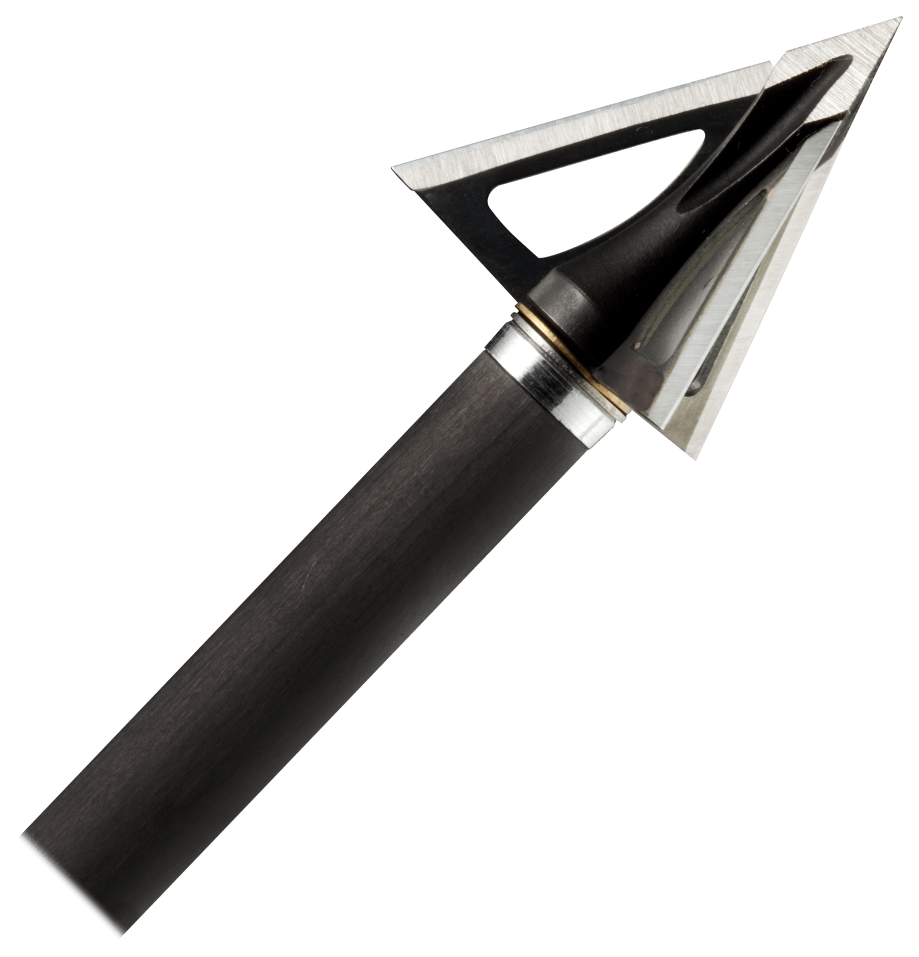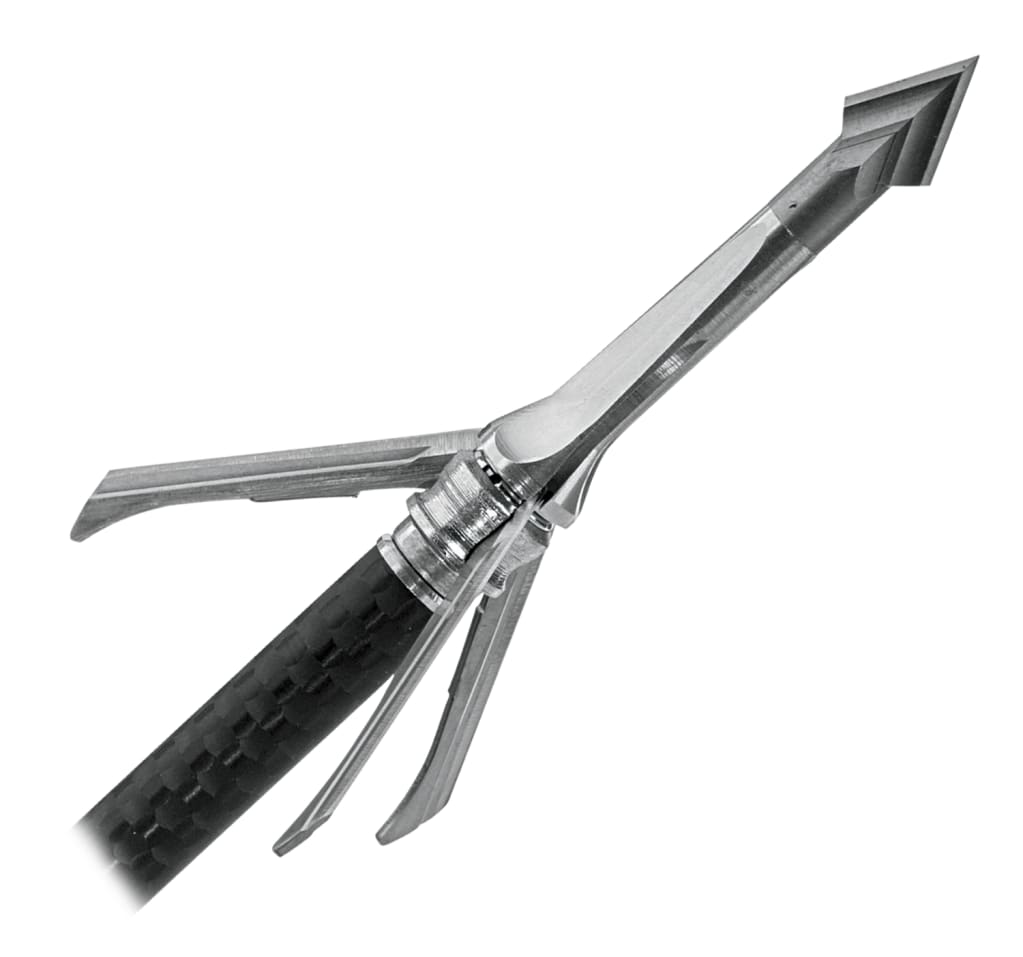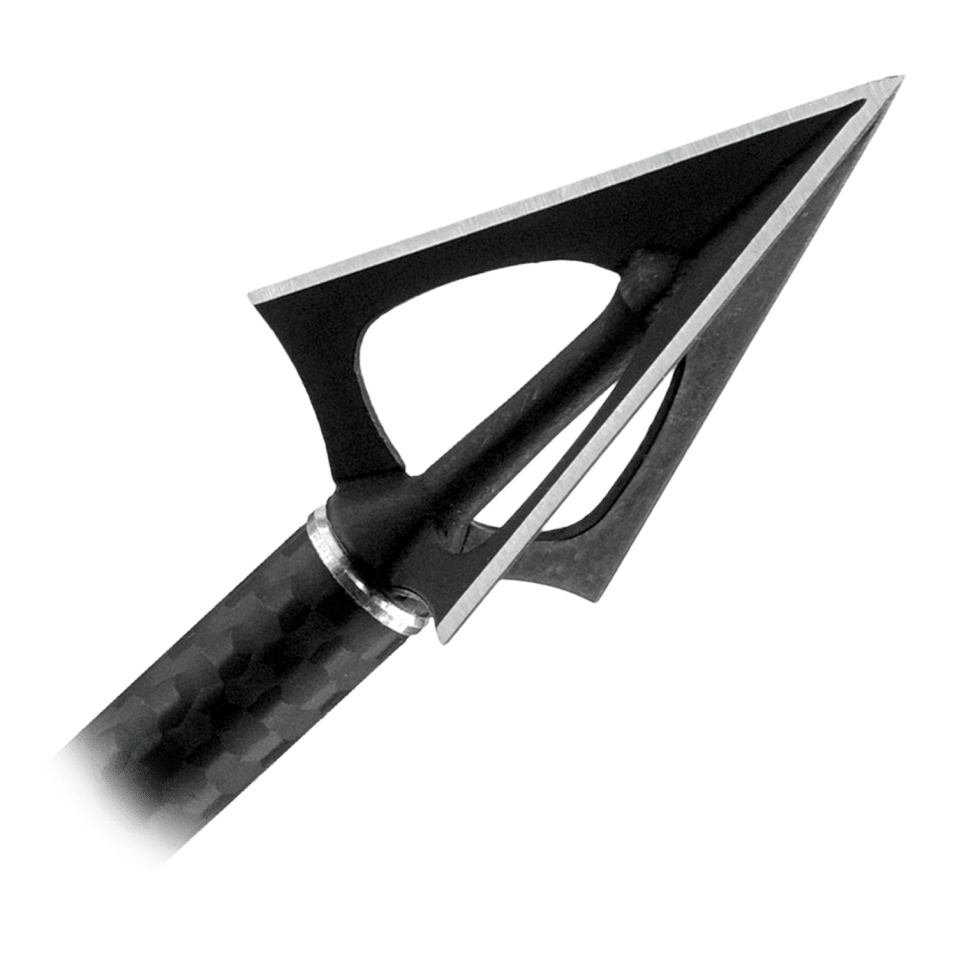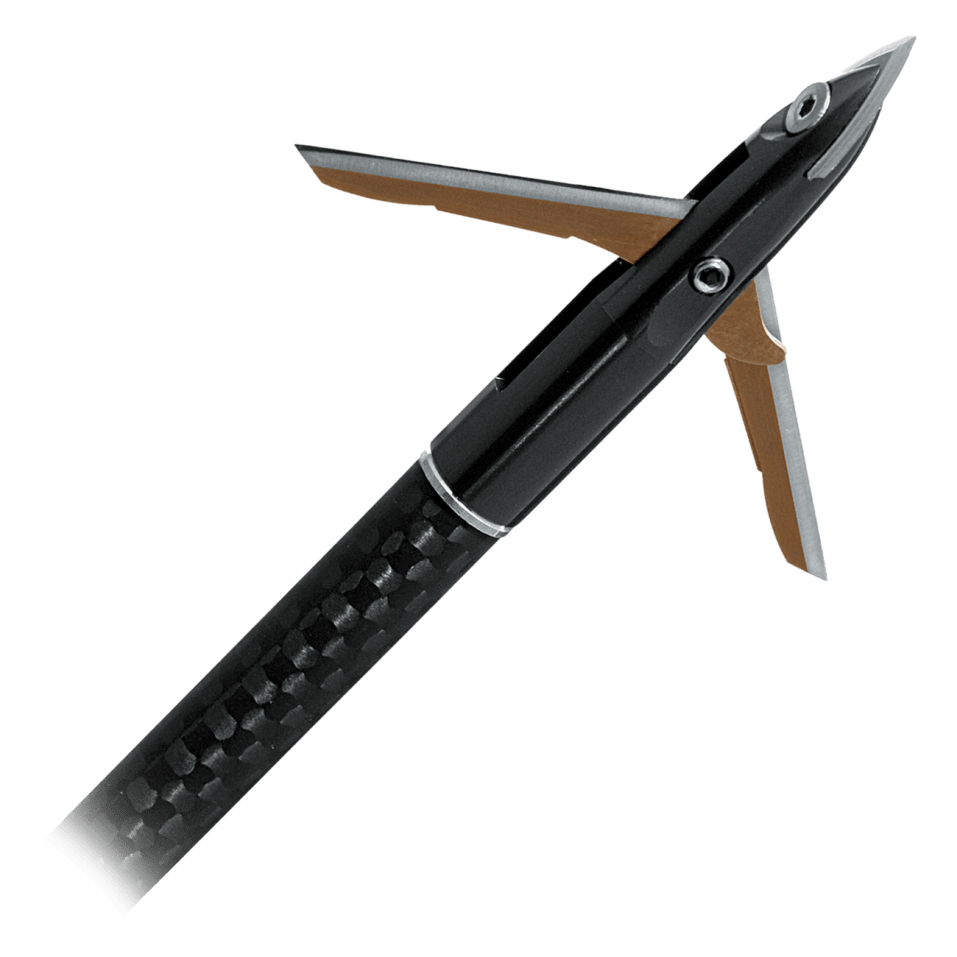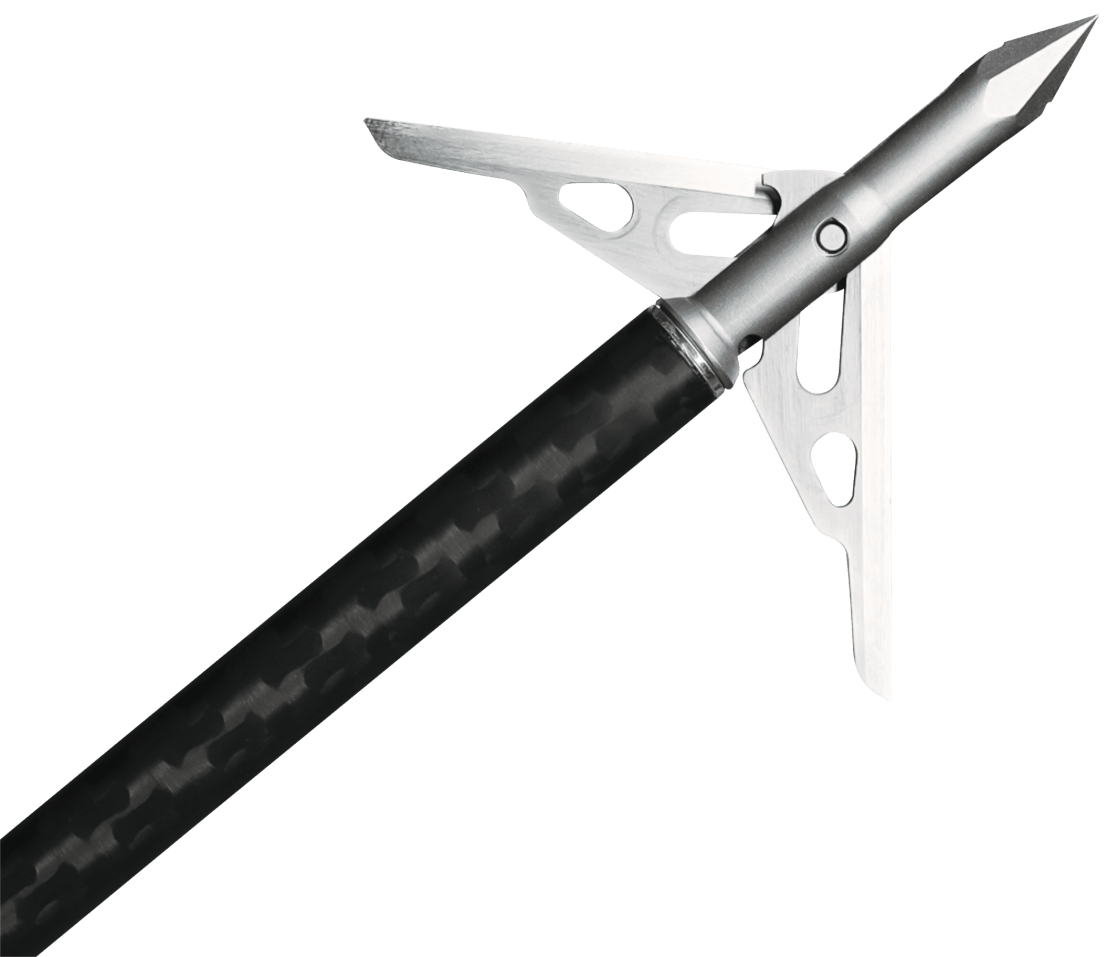
A broadhead is a large cutting point assembly, attached to an arrow shaft for hunting. The proliferation of archery broadhead designs and blade configurations are diverse, making the decision on which one to use under a given set of hunting factors confusing, but it doesn’t have to be so.
Each year manufacturers come out with new models designed to maximize cutting efficiency, minimize flight deviation and increase impact stability, so even if you're content with the broadheads you've been shooting for a long time, it might be worth considering some of the newer broadheads.
The Two Main Broadhead Categories
Broadheads can be divided into two categories based on their physical makeup and further depending on the number of blades they sport. The two main categories are fixed blade broadheads, and mechanical blade broadheads. Within those main categories you will find additional variations or sub categories. Additionally, various designs bridge the basic model descriptions by adding features like cut-on-contact blades on the tip.
BlackOut Toxik Fixed-Blade Broadhead or Replacement Blade
This sleek, technically advanced BlackOut® Toxik® replaceable-blade broadhead represents the ultimate in durability and sharpness. Its precision ferrule is all stainless steel, configured using patented MonoFlow™ technology to ensure superior strength and flight performance. The super-sharp German steel blades, full .030" thick, are securely locked into the ferrule and will remain intact even in the toughest conditions. Cut-on-contact tip for deep penetration. Wide 1-1/16'' cutting diameter.
Shop NowGrim Reaper Razorcut Whitetail Special Mechanical Broadhead - 100 Grain
Reap what Mother Nature has sown with this devastating broadhead, featuring a mechanical 3-blade design with a 2'' cutting diameter that is ideal for whitetail-sized game. Grim Reaper® Razorcut Whitetail Special Mechanical Broadhead are ideal for higher kinetic energy bows. Includes practice head. 3 pack.
Shop NowFor most bowhunters, broadhead selection is a matter of personal preference based on experience, the speed of the arrow and the game being sought. If you're new to bowhunting and short on experience, here are some guidelines.
As a general rule, bowhunters with slower shooting speeds (created by lower draw weights) should use fixed-blade broadheads of 1-1/4” or less to improve penetration. An additional consideration for shooters with slower speeds would be to select a cut-on-contact broadhead. Cut-on-contact broadheads have minimal resistance, which increases penetration and the likelihood of a quick, ethical kill.
Shooters with higher draw weights and faster speeds have more options. Increased kinetic energy will afford the advantage of using larger-diameter fixed-blade or mechanical broadheads. With sufficient penetration, these larger broadheads have the potential to produce heavy blood trails, but there is a point of diminishing returns. Larger blades should be reserved for smaller game such as turkeys when penetration isn't an issue.
The Broadhead Blade Count
The number of blades that a broadhead has will have a direct impact on the blood trail, with more blades producing the best effect. The theory is that with broadheads using three or more blades, at least two are cutting across the grain of muscle tissue, making it less likely you’ll lose a blood trail because of muscle fibers closing up a cut that happens to run with the grain.
Four Broadhead Configurations
- Fixed-blade
- Replaceable Blade – The blades are removable for sharpening or replacement, and on some designs the points are replaceable.
- One Piece – Full-blade broadheads have cutting edges that extend from the tip of the point back to the rear portion of the blade(s). These broadheads are available in two-blade, three-blade and four-blade versions.
- Mechanical heads – Have blades that fold into the body to reduce drag and deflection during flight. The cutting blades extend upon penetration and give these heads their name.
Fixed-Blade Broadheads
Fixed-blade broadheads can be broken down into two categories, one-piece broadheads and those with replaceable blades. Replaceable-blade broadheads are very popular because you don’t have to deal with the tedious process of sharpening the blades’ edges. When they lose their edge, you simply drop in a new razor-sharp blade.
Within these categories you’ll find two-blade, three-blade and four-blade configurations. For novices not as experienced in bow tuning, smaller and fewer would be two words to consider strongly when it comes to broadhead selection.
If your bow is poorly tuned, when an arrow leaves the rest its flight will be affected more readily. An arrow that leaves with its fletching end raised will tend to catch the wind and take a sharp dive in its trajectory. Conversely, when the fletching end drops on release, the lower rear angle will cause the blade to catch the wind and plane upward.
For the same reason, the number and size of blades will have an increasing effect the bigger they get. If you want to minimize tuning your bow, stick with compact broadheads – their smaller surface area reduces the effects of wind and out-of-tune bows compared to larger, higher-profile broadheads. They’re becoming more and more popular, and most manufacturers offer at least one compact fixed-blade broadhead.
BlackOut FXD Cut-On-Contact Fixed-Blade Broadhead
Our one-piece BlackOut® FXD Cut-On-Contact Fixed-Blade Broadhead has been designed to produce frequent pass-throughs and tremendous wound channels. Its strength is exceptional, its accuracy comparable with field points due to the close-tolerance, CAD-driven stainless steel construction. Photon-welded fixed blades come shaving-sharp, fly clean, and create utter devastation at the point of impact, making this the perfect fixed-blade for today's high-performance bows.
Shop NowLeading Edges - Chisel Tip vs Cut on Contact
Broadheads that use a chisel tip will punch through an animal's tough hide before the broadhead's blade surface begins to cut. This helps to ensure the broadhead enters the animal at the desired angle and the trajectory is unaltered. Chisel tips are one of the most durable types of broadheads, and are well known for punching through bone without being damaged.
Cut-on-contact tips don't have to punch through the hide – they instead slice through it. This requires very little energy, therefore maximizing penetration. Cut-on-contact tips are a favorite among traditional archers and those shooting low-poundage bows
Expandable Blade Broadheads (Mechanical)
This ingenious innovation has gotten a bad rap, largely because of a limited number of bowhunters with bad experiences, and justifiably in some cases due to poor initial designs. However, mechanical broadheads have come a long way since they were first introduced.
The truth is that mechanical heads aren't ideal for every application; however, they do meet a need and many dedicated shooters use them successfully every season. Certainly, improvements in original designs have minimized the number of disappointing experiences, but selection for particular applications is also a major factor.
Mechanical heads have one major advantage: they fly in a manner very close to field points and require very little tuning to attain tight groups. The critical issue to keep in mind with mechanical heads is that the blades have no support for the trailing edge. Blades that use thicker metal for the extendable blades will withstand greater stress and have less flex upon impact.
While some mechanical blades are as thin as .020", BlackOut Gator Expandable broadhead two blades are made from razor-sharp, heavy-duty stainless steel that is .030" thick. Also, the length of blade you select should be limited when targeting larger species.
BlackOut Gator Mechanical Broadhead
The amazing BlackOut® Gator Mechanical Broadhead will boost your confidence at the edge of your range. It's simply unsurpassed for accuracy: the two .030" blades have an in-flight diameter of only 7/8'', with ballistic characteristics near that of a field point. After flying straight and true, the free-floating blades deploy from the rear at impact, for penetration far exceeding that of conventional expandables. Expect gaping entries and exits, and an easy trail to follow!
Shop NowG5 Outdoors T2 Two-Blade Mechanical Broadhead
Lean, efficient, and deadly, the G5® Outdoors T2 Two-Blade Mechanical Broadhead delivers a big cutting diameter from a smooth-flying simple design. This sturdy mechanical holds 2 heavy-duty, .032" stainless steel blades in a rugged stainless steel ferrule topped by a sharp chisel tip. The T2's rearward-sliding blades feature a double-bevel blade edge for superior sharpness as they deliver their 2" cutting diameter. Based on G5's proven Ball Lock Retention System, the T2's reusable Slip Lock Retention System holds the blades tightly in place until impact.
Shop NowFor the most part, modern mechanical broadheads are available in two styles: over-the-top (front deploying) and rear deploying. Over-the-top broadheads have blades that are hinged at the rear of the ferrule, and pivot out from the front upon contact. The blades typically open up after they are inside the animal, which ensures the blades are razor-sharp when cutting through vitals.
The entrance holes from over-the-top broadheads are smaller than rear-deploying broadheads. Rear-deploying broadheads have front-pivoting blades that deploy outward from the rear of the broadhead, resulting in full-size entrance and exit holes. This style maximizes blood trails and guarantees the blades are deployed before reaching an animal’s vitals.
While mechanical broadheads are available with blades up to 2-3/4", hunters should limit the size of broadheads to a maximum cutting dia. of 1-1/2" when going after elk or other big-bodied animals. Smaller blade diameters will give you more penetration and improved performance with bigger-boned animals.
That said, there is another factor to consider and that's the force that's driving the business end. Mechanical broadheads around 2” in length are fine for deer-sized animals as long as you have enough kinetic energy to drive them home. Industry experts recommend at least 55 ft.-lbs. of kinetic energy for the larger heads and 65 ft.-lbs. of kinetic energy when going after elk and large game. The 65 ft.-lbs. of kinetic energy translates roughly into the result achieved by launching a 400- to 500-gr. arrow with a 60- to 65-lb. compound bow.
You can use this formula to in order to calculate kinetic energy so you know exactly what you are producing with your particular set up: ke=M * v2 / 450,240.
ke=Kinetic Energy, M=mass (weight of arrow in grains), v= velocity of arrow in fps, 450,240 = (gravitational constant of 32.16 * 7000 [gr.])
For example: An arrow with a weight of 450 gr., traveling at 265 fps will have 70.19 ft.-lbs. of kinetic energy. (450 x 70,225 (265x265) / 450,240 = 70.187).
With mechanical broadheads, you still need to tune your bow to achieve maximum performance in both penetration and accuracy. The adjustments required to perfect your setup are less than with traditional broadheads, but even slight variations in flight can rob you of valuable energy. Tuning is time well spent regardless of what you shoot. A good compromise for mechanical broadheads is to shoot the smallest diameter, so that you get maximum penetration and still have the advantage of the accuracy characteristics of mechanicals.
Determining the Broadhead Weight You Want
The next decision after determining which style of head you want is the weight. Industry experts recommend 100-gr. broadheads for carbon and lightweight aluminum shafts, and for heavy aluminum shafts, 125-gr. heads.
Once you decide which weight and style of broadhead you want to use, it is incumbent upon you to set up and tune your bow for true broadhead flight. Before you start tuning, make sure your arrows are perfectly straight and that the broadheads are installed properly. You can check head alignment by spinning your arrows to make sure there is no wobble of either head or shaft. Keeping half a dozen arrows set aside strictly for hunting is a good idea, since it eliminates the potential wear from use during practice sessions.
5 Broadhead Tuning Tips
Even after tuning your bow for target shooting using methods like paper tuning and walkback tuning, your broadheads still may not group with field points. This broadhead-tuning method is an easy way to get them grouping together, assuming you have a properly tuned bow and correctly spined arrow. You can broadhead tune at any range, although the planing effect of broadheads is greater the farther the distance. 25-30 yds. is the most common broadhead tuning distance. Be sure to use a fixed-blade broadhead for tuning, as they will exaggerate the imperfections in your bow setup more than mechanical broadheads.
- Shoot a group of three or four field points at the target, making sure you are properly sighted in for your shooting distance.
- Shoot two broadhead-tipped arrows at the same spot, and take note of where they hit. If they group with your field points, your bow is already tuned for hunting (however, check at longer distances just to make sure). If they don’t, you will want to “chase” your field points with the rest. For example, if your broadheads group low and to the left of your field points, you’ll want to move your rest up and to the right (only move in one direction at a time, so pick either vertical or horizontal rest travel and make one of those adjustments before moving on to the other). Make only small adjustments at first – assuming your bow has been paper- or walkback-tuned, you will probably not need much adjustment at all. Do not move your sights at this stage, as that will come later.
- Shoot another group of field points (always keeping the same aiming point) and then a group of broadheads, taking note of where each group hits. Make rest adjustments accordingly. Although you are aiming at the bull’s-eye, the ultimate goal for this step is to get your broadheads and field points grouping together. Chances are high that once your field points and broadheads are flying the same, they will not be hitting your exact aiming point (this is normal and will be addressed in the next step). Repeat this step – making rest adjustments in only one direction at a time – until your field points and broadheads are flying interchangeably.
- When your broadheads and field points are flying together, your bow is tuned for perfect hunting-arrow flight. Check each of your sight pins (or your sight tape) and make any necessary windage and elevation adjustments, and shoot a mix of field points and broadheads at varying distances to make sure they’re flying together.
- To ensure a quick and humane kill, you'll also need to spend some time practicing with your new broadheads. Even the biggest, sharpest broadheads will not bring an animal down if they hit a non-vital part of the animal's body. Practice how you’ll likely end up shooting – sitting, kneeling, through tight windows, during high winds and adverse weather, with an elevated heart rate, up and down hills and any other scenario that you may come across in the field. Confidence in your equipment and staying within your physical limits are the biggest factors in making clean, ethical kills.
- 18176 views


